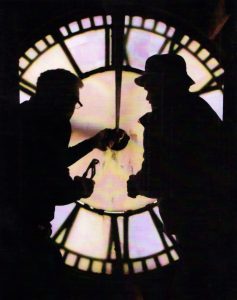Genealogists are shy, retiring creatures, averse to daylight. Seeing so many of us at Back To Our Past over the last few days, all out in the open, blinking nervously at each other, was just a tad disturbing.

But, as ever, it was very worthwhile.
Yes, the event is full of ordinary, decent punters driven a little doolally by FoMO (Fear of Missing Out), as they try to collect every last piece of free paper from every single stand in the RDS. Yes, the corporate pitches can be teeth-grindingly high-powered. Yes, there’s always a vague but persistent sense that it’s all pointless but you still have to be there.

But you do have to be there. Nowhere else is there anything even remotely similar, with the entire gamut of those involved in genealogy in Ireland on display, from the billion-dollar-Ancestry.com to the humblest of crumbs-from-the-table self-publishers.
This year again the Genetic Genealogy Ireland conference ran as a welcome symbiote, and drew packed houses. I only managed a few of the talks, but got some of the best and worst. One jargon-filled hour interpreted in excruciating detail new methods of identifying chromosome subgroups within subgroups within subgroups. It reminded me of Lord Rutherford’s classic remark: “All science is either physics or stamp collecting.” This was stamp-collecting on steroids.
On the other hand, Paddy Waldron’s talk “The Ups & Downes of atDNA matching” (available here) was complex but a model of clarity, using case studies to show just how useful a tool autosomal DNA matching can be when mixed with existing research sources and trustworthy family trees. It persuaded at least one sceptic (me) that, in the right circumstances, atDNA can be a powerful clarifier of family history beyond the horizon of documentary research.
One aspect of the corporate selling of genealogical DNA tests got no attention at the conference. The ethnicity calculator used (especially by Ancestry) to sell its tests will tell you you’re 12% Native American, 60% Irish and 38% Viking. When challenged, the corporate PR response is to describe this as a harmless piece of fun. It’s not.
Ethnicity testing has become one of the main selling points of the phenomenally profitable genealogical DNA testing industry. It is pitched at and attracts many people with no interest in genealogy, who think they’re getting a scientific breakdown of their ethnic makeup. That’s just not true. It is pseudo-science at its worst, running on the unspoken but still queasy implication that race has some scientific basis – see here for a summary of the truth.
Apartheid South Africa used to have a test for distinguishing Blanke from Nie-Blanke. If your hair was curly enough to hold up a pencil, you were Nie-Blanke. Scientifically and ethically, DNA ethnicity testing is its contemporary equivalent.
Very interesting! I often wonder about the DNA testing. Have to read a lot more. Thanks John. Really enjoy your posts.
Sandy LaFerriere
Very interesting, John – thanks for the “trip report”! Your mention of DNA testing really jumps out to me on two counts:
1. Many of our members – who pursued Y-DNA testing for many years with diminishing returns, switched to Autosomal and were very surprised at the additional number of matches. These new matches then helped them to build on the research of others. I guess this new usefulness is down to the explosion in the number of Autosomal testees over the past 3 years. Which leads me on to my second point….
2. Many of those additional Autosomal testees were lured into testing by the bright flowery promise of calculating their ethnicity mix. I can see your point on the subjective “science” behind the ethnicity testing – but I have also noticed how so many of the people tested are happy with the headline result, and have no wish to dive deeper into the “stamp-collecting” aspect of their personal genealogy.
As I am a pure Irishman 😉 living on the island of Ireland – I was curious how such tests would turn out for myself. The Y-DNA test produced very few matches for contacting – and I thought that was it. However, just 3 months ago I took the Autosomal test and while I came back as 100% Irish (phew) – I was delighted with the hundreds of useful connections that sprang up. I must say, I was surprised at this as many of my ancestors parted ways with their emigrating relatives 5 generations ago or more – and the test is not meant to be very useful back beyond 4 generations. So, I think we are seeing the magic of a large datebase, and related network effects at work here.
Thanks for the thoughtful article – and all the best – Mike.
Did Massey Ferguson have a stand? They always had great brochures at The Spring Show.
Excellent and useful post. I am forwarding it to several cousins who are tied up in knots over this ‘ethnicity’ thing after getting their results from Ancestry.com.
I’ve toyed with the idea of testing my Y-DNA as that goes back to Ireland but the cost of these tests has put me off. I would hate to pay out a lot of money and be disappointed with the results.
Hi John. A thought provoking article which I enjoyed. Have a YDNA with 3 reasonable matches (one in Ireland) 0 variance for my younger brother backed by paper trail. Now my youngest sister is doing autosomal DNA to see if it provides reasonable matches too.
All my grandparents are from Ireland. Ancestry said I’m 99% Irish. 23&Me said I’m 96% Irish with a touch of Scandinavia. Pretty accurate I think, lol.
Love your description of Paddy Waldron’s talk – “complex but a model of clarity.” Now that more family archivists are using DNA, this is exactly what is needed.
John: I pleaded with my brother to do Y DNA with FT because we have no idea who we are. Surname is ostensibly Norman but cannot find either our initial surname emigrant from about 1850 arrival in US nor his wife, whose surname we know for certain, in any Irish records. So didn’t even know where in Ireland our family’s last residence and probable origin place was. It was my last hope. Got back vanilla M269 but awaiting add-on results from L226 add-on pack to confirm whether we might be part of one of Irish types. I’m a believer, at least so far. And it looks like it it might have led to a breakrough. But full disclosure – not from the Y ironically. It’s from the matches the 67 marker test gives you, which I assume are akin to the 23/me and ancestry autosomal. And maybe we’re finally on a trail. He matches with two people, strangers, who found each other through the same matches earlier. And we all share that original emigrant grandmother’s surname. So round-about but FT process brought me them and neither 23/me nor ancestry helped one bit except to bring us some relatively close living family descendants from other known lines here in states. Appreciate knowing them but didn’t help at all with the big brick wall that’s deviled me for decades. And now it’s possible the Y will confirm that we’re from the same area his wife’s connections point to. I’ve always believed we were from there. Maybe my intuition was grounded in fact. So was worth it for me anyway. Expensive as it was with the Y plus the Snp pack.
I wonder how long it will be before someone in law enforcement gets a warrant to match a suspicious DNA sample against commercial DNA databases such as Ancestry and 23 &Me.
The results probably would not be worth it though, if you only match to unknown third cousins – “When did your family last have contact with your grandfather’s uncle? Where was he then?”
Mind you, the bragging rights – “Did you know we are related to Joe Soap, the notorious axe murderer?”